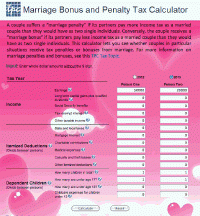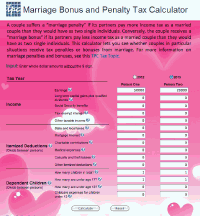The voices of Tax Policy Center's researchers and staff

 its Valentine’s Day finery, ignores the new 0.9 percent Medicare payroll tax hike buried in the 2010 health law. The extra levy affects only a few high-income couples but in very different ways. Lucky couples will collect marriage bonuses of up to $450. But those less fortunate—if anyone making $250,000 can be considered less fortunate—will incur marriage penalties of as much as $1,350 in additional Medicare tax.
its Valentine’s Day finery, ignores the new 0.9 percent Medicare payroll tax hike buried in the 2010 health law. The extra levy affects only a few high-income couples but in very different ways. Lucky couples will collect marriage bonuses of up to $450. But those less fortunate—if anyone making $250,000 can be considered less fortunate—will incur marriage penalties of as much as $1,350 in additional Medicare tax.
The culprit? The income thresholds for paying the tax. The new levy equals 0.9 percent of wages above unindexed thresholds—$200,000 for singles and $250,000 for married couples. Because the threshold for couples is less than double that for singles, the tax imposes a marriage penalty on couples with two high earners but gives a bonus to those with a high earner and a low- or non-earner.
Consider the simplest case of a penalty: each spouse earns $200,000. If they weren’t married, they wouldn’t owe the new tax because their separate earnings don’t exceed the singles threshold. As a married couple, their $400,000 combined earnings are $150,000 over the threshold for couples and they owe 0.9 percent of that in tax—$1,350.
The penalty stays the same if their earnings grow. As long as each has earnings above $200,000, they’ll pay $1,350 more each year. Marriage takes away $150,000 of the total exclusion the tax provides for two single workers.
Who are the lucky duckies for whom marriage will cut the tax? Couples with one spouse earning more than $200,000 and the other earning less than $50,000.
Consider again a simple case: a woman making $250,000 and her stay-at-home hubby. Unmarried, she owes the new tax on $50,000—$450. Married, that tax bill goes to zero. The savings derives from the $50,000 additional exemption that comes with marriage. That bonus shrinks if the husband starts working and goes away entirely if he makes more than $50,000.
It would be easy to get rid of those penalties and bonuses—just tax earnings separately for each worker the way we do with other payroll taxes. As long as the tax applies to a couple’s total earnings, there have to be either bonuses or penalties or both.
Posts and comments are solely the opinion of the author and not that of the Tax Policy Center, Urban Institute, or Brookings Institution.
